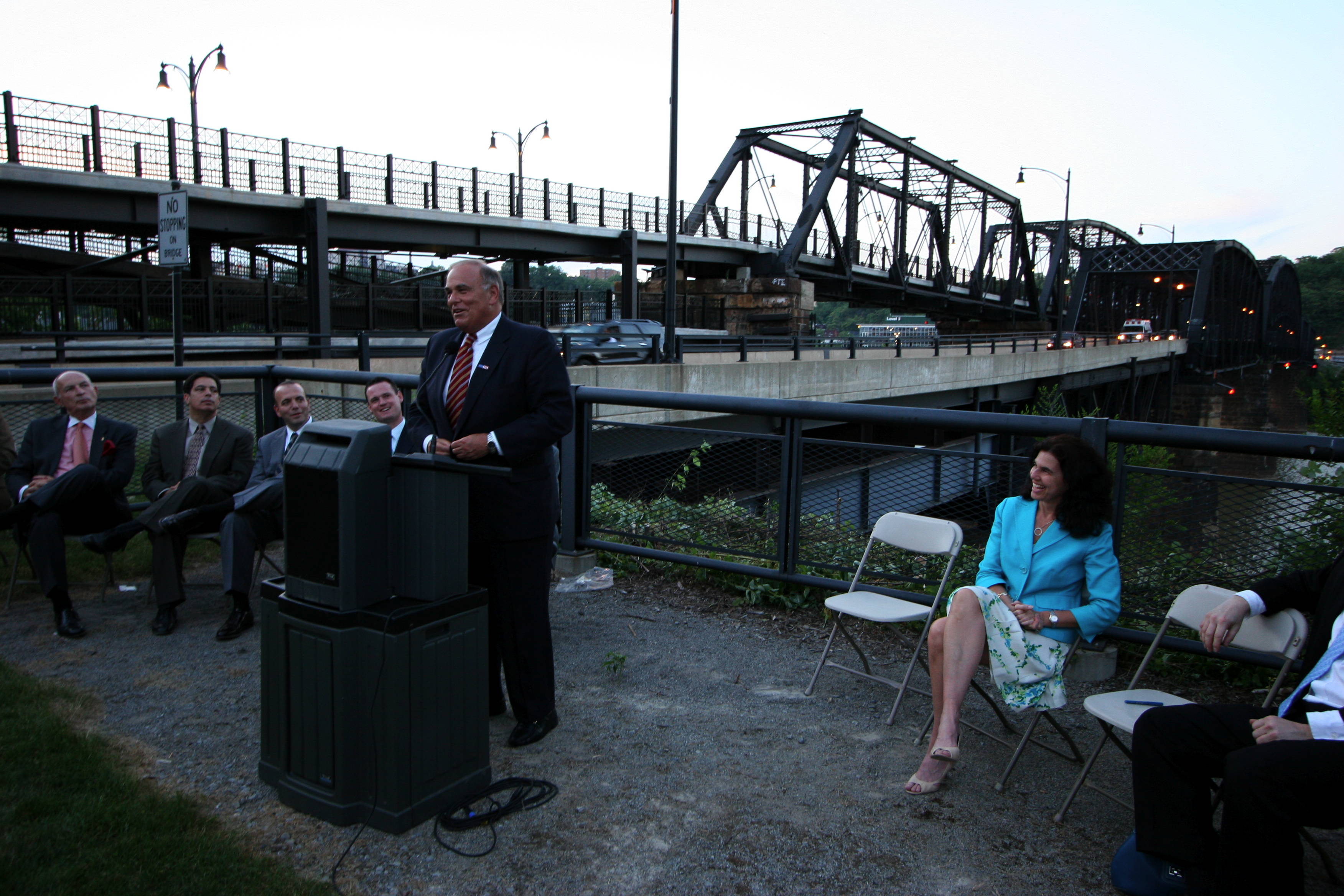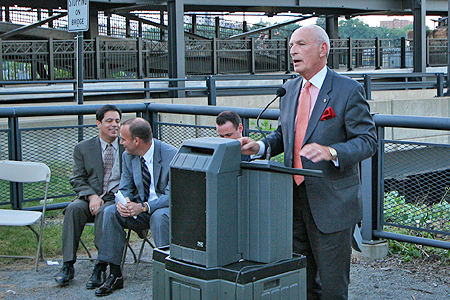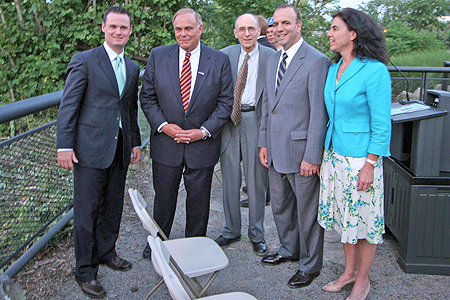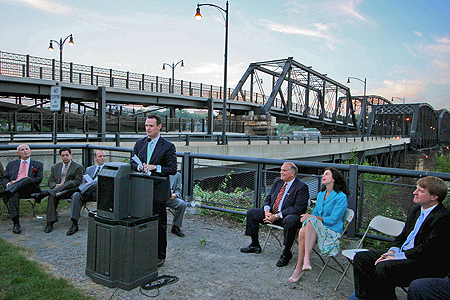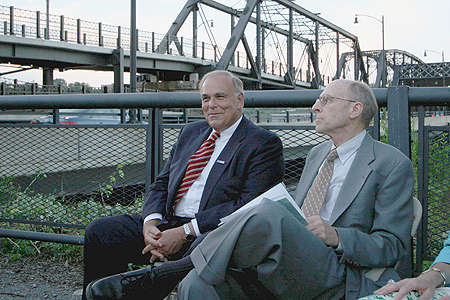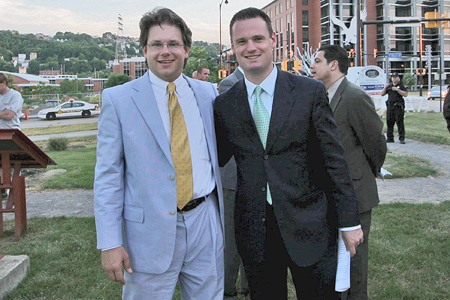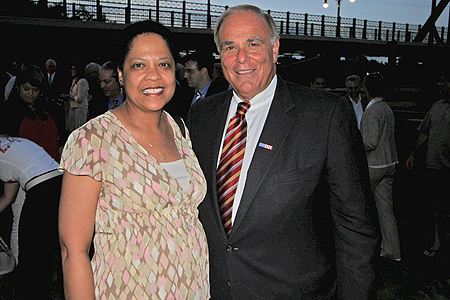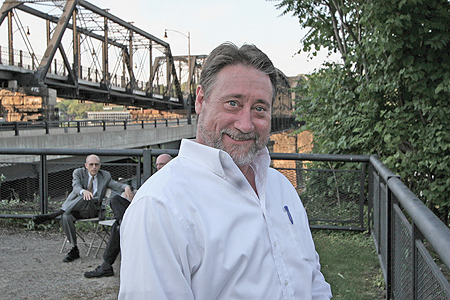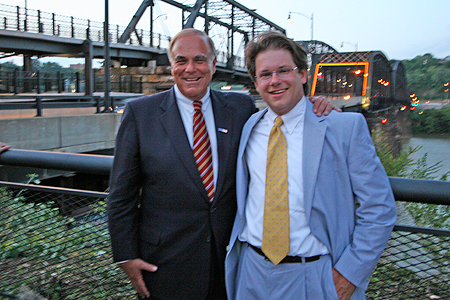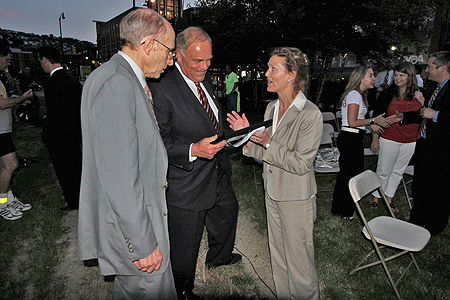
Category Archive: PHLF News
-
LCCC Helps With Vacant Lots
On Thursday, July 17th, Josie Bryant, Parish Social Minister for St. James Church and founder of Stone Soup and Serenity Community Gardens in Wilkinsburg, received something she’s been waiting for for over five years.
In cooperation with St. James Church and Home Depot, Landmarks Community Capital Corporation (LCCC) orchestrated the purchase of a riding lawnmower to help Josie and her volunteers tackle the difficult task of maintaining many of the vacant lots on Franklin Ave in Wilkinsburg, in addition to maintaining the community gardens she and so many have worked hard to get started. Josie’s grassroots initiatives are a vital component in fostering Wilkinsburg’s revitalization.
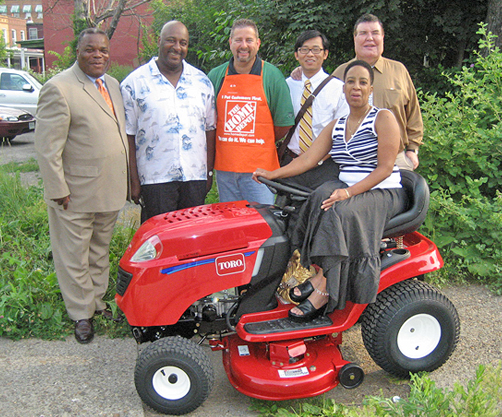
-
Public Hearing at Historic Review Commission on Redesign of Market Square
PREPARED TESTIMONY OF
ANNE E. NELSON, ESQ.
GENERAL COUNSEL
PITTSBURGH HISTORY & LANDMARKS FOUNDATION
BEFORE HISTORIC REVIEW COMMISSION, CITY OF PITTSBURGH
PUBLIC HEARING ON MARKET SQUARE REDESIGN
JULY 2, 2008
Landmarks is investing $3.5 million to restore four historic buildings in Market Square located between Market and Graeme Streets, the design of which was predicated on Market and Graeme being open to vehicular traffic from Fifth Avenue into the Square. This project includes retail on the first floor and seven affordable apartments on the upper floors that will use Graeme Street as an entrance. We will have a green roof and are doing the buildings to LEED standards.
However, the redesign plans chosen close Graeme Street and that has us alarmed. We do not see how people are going to want to rent apartments on a dead end street. People do not frequent dead end streets; they want the ability to bring people to the door, load and unload things. Furthermore, how will the trash be collected?
Historically, Market Square has always had full traffic access. Removing traffic from the street has worked almost nowhere in the United States and almost every street where traffic was removed has been reconverted to have traffic flowing again in order to bring people back. Examples of traffic removed include East Liberty and Allegheny Center in Pittsburgh, and traffic was eliminated on Chestnut Street in Philadelphia and Fourth Street in Louisville and both lost retail and now have it back since traffic was reopened.
If Graeme Street is closed, Landmarks does not know whether it should complete construction of the project. I ask you, would you like to live on a dead end street that has no provisions for dropping off or turning around? When thinking about this question, remember that in Pittsburgh during a lengthy part of the year, the days are short and the weather is bad.
We question our investment of $3.5 million in Market Square if Graeme Street is closed.
-
Public Hearing on St. Mary’s Academy Building
PREPARED TESTIMONY OF
ANNE E. NELSON, ESQ.
GENERAL COUNSEL
PITTSBURGH HISTORY & LANDMARKS FOUNDATION
BEFORE HISTORIC REVIEW COMMISSION, CITY OF PITTSBURGH
PUBLIC HEARING ON ST. MARY’S ACADEMY BUILDING
CITY HISTORIC STRUCTURE NOMINATION
JULY 2, 2008
Pittsburgh History & Landmarks Foundation (Landmarks) strongly supports the nomination of the Academy Building of the St. Mary’s Church complex to become a City-Designated Historic Structure.
The St. Mary’s Academy Building was listed on the first county-wide architectural survey conducted in the United States, undertaken by Landmarks in 1966, and chosen as one of the buildings published in Landmark Architecture of Allegheny County Pennsylvania by James D. Van Trump and Arthur P. Ziegler, Jr. The Academy Building was also listed in 1979 in the second countywide survey of historic architectural sites conducted by Landmarks, in association with the Commonwealth of Pennsylvania. It was chosen for inclusion as one of 600 out of the 10,000 surveyed in the major book based on this survey, Pittsburgh’s Landmark Architecture by Walter C. Kidney, published in 1997. Both Van Trump and Kidney consider the Greek Revival c. 1850 Academy Building a significant surviving example of an important American architectural style. Furthermore, its “curious ornamental cast iron porch” is “the sort usually associated with New Orleans or Mobile although once common too in the industrial North.”
In 1989 historian Roger Kennedy noted in his National Trust book Greek Revival America: “The Northern Greek Revival was at least as vigorous and diverse as that in the antebellum South; but all the great houses of the North … have fallen victim to that region’s industrial success.” This is also true of banks, courthouses, and modest Greek Revival structures like St. Mary’s Academy, and we should protect the limited number of survivors.
Of the buildings in the St. Mary’s Church complex, the Academy Building is not only the oldest, but is the most architecturally unique and should, therefore, be deemed a City-Historic Structure.
-
Public Hearing at City of Pittsburgh Council on the Malta Temple City Historic Structure Nomination
PREPARED TESTIMONY OF
ANNE E. NELSON, ESQ.
GENERAL COUNSEL
PITTSBURGH HISTORY & LANDMARKS FOUNDATION
BEFORE THE PITTSBURGH CITY COUNCIL
PUBLIC HEARING ON THE MALTA TEMPLE
CITY HISTORIC STRUCTURE NOMINATION
June 25, 2008
Pittsburgh History & Landmarks Foundation supports the nomination of the Malta Temple Building to be a city-designated historic structure.
The former meeting house of the Ancient and Illustrious Order of the Knights of Malta is noteworthy for its historical and architectural character. Furthermore, the building’s location, as part of the continuous streetscape of the historic North Avenue next door to the Federal North block, which is also significant. Therefore, the Malta Temple Building should be preserved for the benefit of the residents of Pittsburgh.
The Salvation Army intends to replace the current structure with a building that is almost identical in style and design to the current structure. The reason for the new building is that the existing floor plates do not support the services the Salvation Army needs to offer at that location. Landmarks is currently rehabilitating four historic buildings in Market Square and has altered the floor plates and interiors to meet the new uses of the building. This is done with numerous historic properties.
Landmarks offers its assistance to the Salvation Army in planning to reuse the structure.
-
Hot Metal Bridge Lighted
PHLF News
June 13, 2008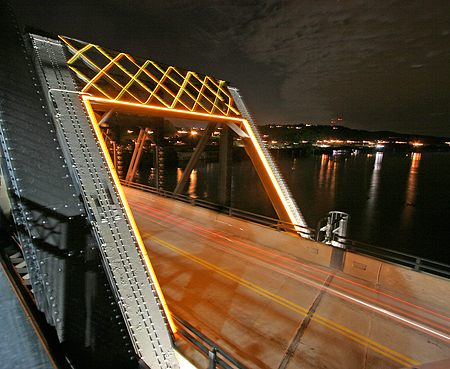
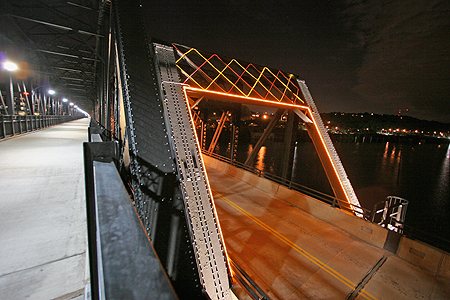
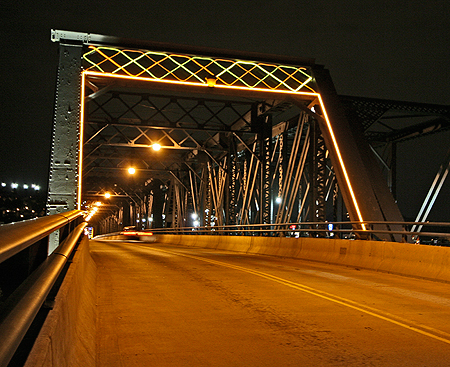
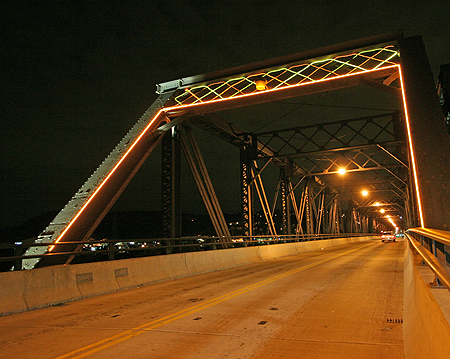
Governor Edward G. Rendell, accompanied by Mayor Luke Ravenstahl, activated the lighting of the portals of the Hot Metal Bridge, as it is commonly called today, at 8:15 p.m., Thursday, June 12, 2008.
The ceremony took place at the Steelworkers’ Monument on the South Bank of the Monongahela River. This was the third bridge decoratively lighted under the auspices of Pittsburgh History & Landmarks Foundation (Landmarks). The first was the Smithfield Street Bridge and the second was the Roberto Clemente Bridge.
Actually, the portal lighting decorates the Main Bridge (Monongahela Connecting Railroad Bridge), constructed in 1904 and opened to motor vehicles in 2000. The Hot Metal Bridge of 1900 (opened to bicycles and pedestrians in 2007) replaced the original Hot Metal Bridge of 1887. With the opening of Hot Metal Street in South Side Works, the name “Hot Metal Bridge” is now commonly used to refer to the historic bridge pair that is built on a shared set of piers.
Historically, hot metal––iron just smelted in a blast furnace and still close to 3,000 degrees Fahrenheit—was transported in ladle cars from the blast furnaces on the north shore of Jones & Laughlin’s Pittsburgh Works across the Hot Metal Bridge of 1900 to the Bessemer converters and open-hearth furnaces of the South Side Plant. The Main Bridge of 1904 served the general purposes of the Monongahela Connecting Railroad, including the transportation of steel ingots and slabs.
The bridge lighting is LED tubular lighting in orange, red, and yellow, suggesting the colors of the hot metal and steel slabs that were once transported across the bridges.
Grenald Waldron Associates of Philadelphia designed the lighting for the bridge as they did for the Roberto Clemente Bridge. Courtney Sarge was the principal designer.
The Governor said, “Grenald has done excellent work once again, we are delighted to see Landmarks utilizing Pennsylvania designers and Pittsburgh contractors for the work that they do with bridge lighting.”
Funding for the project came primarily from a grant from the Department of Community and Economic Development at the Governor’s request. That grant totaled $125,000. Design of the lighting was financed by grants from the Soffer Corporation, the International Brotherhood of Electrical Workers, Wellington Power, and Landmarks totaling $12,500. Landmarks also underwrote an additional $15,000 of costs for the project, bringing the total to approximately $150,000.
Mayor Ravenstahl pointed out, “This is another fine public-private accomplishment in our goal to make Pittsburgh a uniquely attractive city by capitalizing on our historic assets. We thank the Governor and Landmarks and our city team for bringing about this excellent result.
Mark Bibro, Chair of Landmarks, said, “We are grateful that we have a governor who understands the significance of lighting these great engineering monuments to promote their continued use and increase tourism. We are the ‘City of Bridges,’ with 446 bridges (based on the most recent count) within the City limits, and hundreds more throughout Allegheny County. We must continue this lighting program.
Founded in 1964, the Pittsburgh History & Landmarks Foundation works to identify and save architectural landmarks; revitalize historic neighborhoods; and instill community pride. Visit www.phlf.org or call 412-471-5808 for information about preservation services, educational programs, and membership benefits.
# # #
-
Hot Metal Bridge Portal Lighting June 12th
Pittsburgh History & Landmarks Foundation, Governor Edward G. Rendell, and Mayor Luke Ravenstahl invite you to join us in lighting the portals of the historic Hot Metal Bridge, which spans the Monongahela river at the South Side Works.- Time: 8:15 p.m.
- Meeting Location: Meet at the South Side Works at Hot Metal Street and the Hot Metal Bridge at the Steel Worker’s Monument ont he south bank of the Monongahela River.
- Fee : FREE
-
PHLF Main Street Program Expands
By Ethan Raup
Manager, Community Revitalization ProgramsThe PHLF Main Street revitalization program expanded this spring into Armstrong County with a partnership with the Freeport, Leechburg and Apollo Group (FLAG) and with funding obtained by Sen. Jim Ferlo. PHLF is working with FLAG to submit their state main street application in August. If accepted, FLAG would be the first regional main street program in western Pennsylvania.
Freeport, Leechburg and Apollo are small towns with traditional main street business districts that are within 10 miles of each other along the Kiskimenitas and Allegheny Rivers. Alone, each town is too small to qualify as a state main street. So leaders in these towns decided to join together to pursue the state’s regional main street designation.
PHLF’s work includes staffing FLAG’s Board and its four committees – Promotions, Design, Organization and Economic Restructuring. We are developing an aggressive five year work plan that builds on local assets and addresses challenges head-on. We are also taking early implementation steps wherever possible. That includes a study to explore restoring and returning the former Leechburg Hotel building to its original use.
With direct access to the Kiski River, a picturesque surrounding countryside, abundant trail connections and traditional towns that are still largely intact, the FLAG communities have a real opportunity to develop into a regional destination. The Leechburg Hotel could be key to this effort. And it dovetails nicely with PHLF’s work on the historic main street in Vandergrift, which is just across the Kiski river in Westmoreland County.
The FLAG effort began two years ago with the help of Sen. Ferlo, who has been a strong advocate for FLAG and this revitalization effort. We are optimistic that FLAG will receive its Main Street designation later this year. PHLF anticipates working hand in hand with FLAG in 2009 and beyond to help breathe new life into each town.
With the FLAG communities, PHLF is now active in 8 main street revitalization efforts across southwestern Pennsylvania, including Stowe, Swissvale, Tarentum, Elizabeth and Vandergrift. In each of these towns, PHLF is drawing upon our depth of experience and expertise to find a path forward that we believe will lead to a sustained revitalization.
-
Federal North Postponed
The Urban Redevelopment Authority selected PHLF to lead the planning and possibly serve as the developer of the Federal North block, which consists of the Garden Theatre, Masonic Hall, Bradbury Apartments and miscellaneous other historic buildings in the North Side.
The North Side neighborhoods asked that a full-fledged community process be undertaken to establish priorities for the entire North Side and to make recommendations for the Federal North project. PHLF recommended that the process go forward and that Federal North studies be delayed until that is completed.
The current state of the financial and leasing markets is such that the delay will be opportune. The URA has agreed with the postponement with the provision that it may begin some restoration work to open a community office in one of the Federal North buildings.


